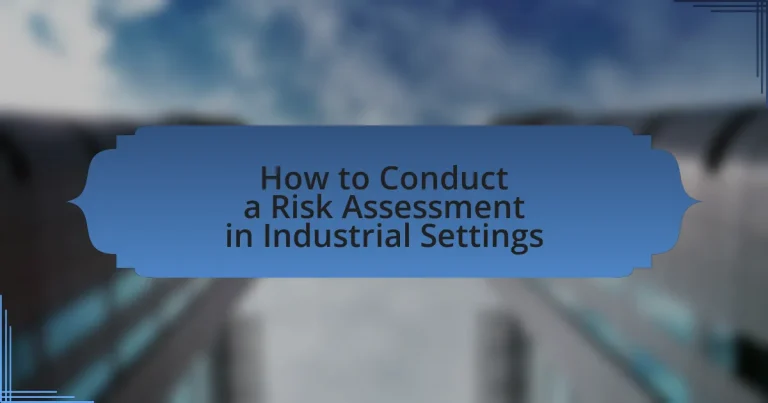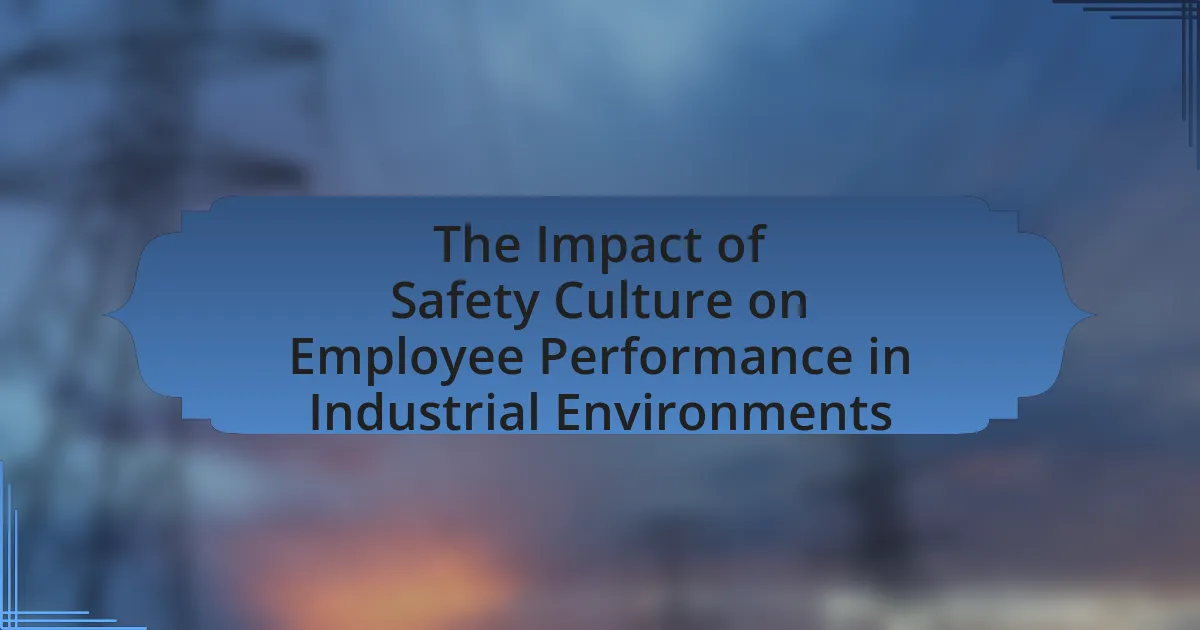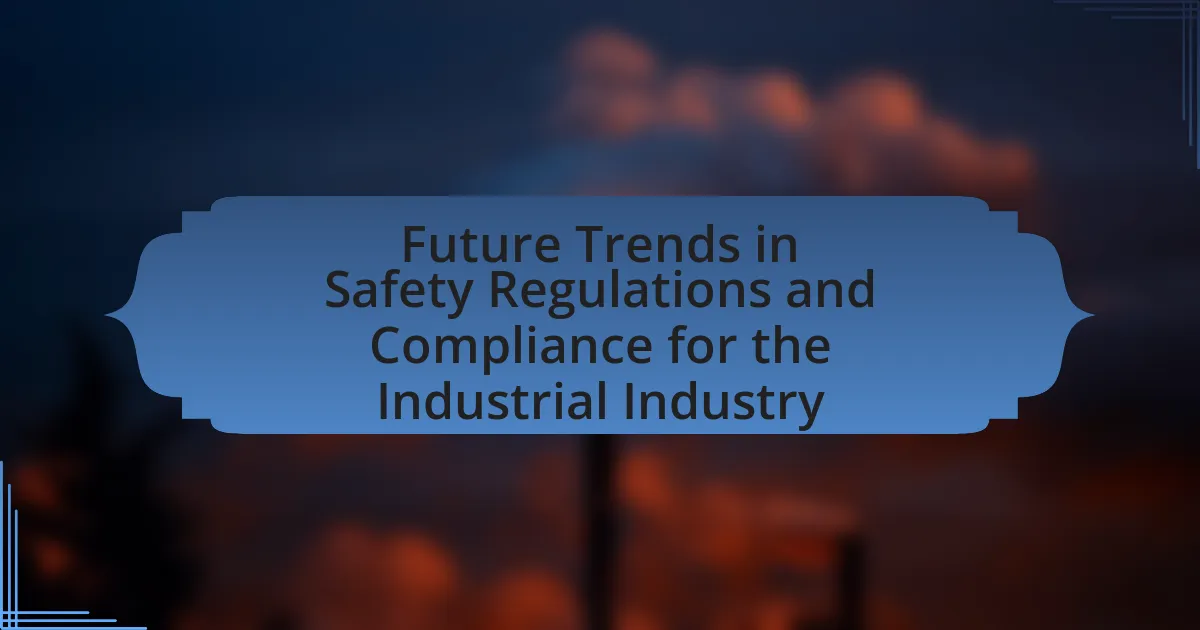A risk assessment in industrial settings is a systematic process aimed at identifying, evaluating, and prioritizing workplace hazards to enhance safety and compliance with regulations. The article outlines the importance of conducting risk assessments, the potential consequences of neglecting them, and the key components involved in the process, such as hazard identification and risk evaluation. It also discusses methodologies for risk assessment, common challenges faced, and best practices for effective implementation. Additionally, the article highlights the legal and regulatory requirements governing risk assessments and emphasizes the role of employee involvement and ongoing training in improving safety outcomes.
What is a Risk Assessment in Industrial Settings?

A risk assessment in industrial settings is a systematic process for identifying, evaluating, and prioritizing risks associated with workplace hazards. This process involves analyzing potential sources of harm, assessing the likelihood of their occurrence, and determining the severity of their impact on employees, equipment, and the environment. According to the Occupational Safety and Health Administration (OSHA), effective risk assessments help organizations implement appropriate control measures to mitigate identified risks, thereby enhancing workplace safety and compliance with regulatory standards.
Why is conducting a risk assessment important in industrial environments?
Conducting a risk assessment is important in industrial environments because it identifies potential hazards and evaluates the risks associated with them. This process enables organizations to implement effective control measures, thereby reducing the likelihood of accidents and injuries. According to the Occupational Safety and Health Administration (OSHA), workplaces that conduct regular risk assessments can decrease workplace incidents by up to 40%. By systematically analyzing risks, companies can prioritize safety initiatives, comply with regulatory requirements, and protect both employees and assets.
What are the potential consequences of neglecting risk assessments?
Neglecting risk assessments can lead to severe consequences, including increased workplace accidents and financial losses. Without identifying potential hazards, organizations expose employees to unsafe conditions, resulting in injuries or fatalities. For instance, the Occupational Safety and Health Administration (OSHA) reports that workplaces with inadequate risk assessments experience higher incident rates, which can lead to costly legal liabilities and increased insurance premiums. Additionally, neglecting these assessments can damage a company’s reputation, as stakeholders may perceive a lack of commitment to safety and employee well-being.
How does risk assessment contribute to workplace safety?
Risk assessment significantly enhances workplace safety by identifying potential hazards and evaluating the risks associated with them. This systematic process allows organizations to implement appropriate control measures to mitigate identified risks, thereby reducing the likelihood of accidents and injuries. For instance, a study by the National Institute for Occupational Safety and Health (NIOSH) found that workplaces that conduct regular risk assessments experience a 30% reduction in workplace injuries. By proactively addressing safety concerns, risk assessments foster a safer work environment and promote employee well-being.
What are the key components of a risk assessment process?
The key components of a risk assessment process include hazard identification, risk analysis, risk evaluation, and risk control measures. Hazard identification involves recognizing potential sources of harm in the industrial setting, such as machinery, chemicals, or environmental factors. Risk analysis assesses the likelihood and severity of harm resulting from identified hazards, often using qualitative or quantitative methods. Risk evaluation compares the estimated risks against predetermined criteria to determine their significance and prioritize them for action. Finally, risk control measures are implemented to mitigate identified risks, which may include engineering controls, administrative changes, or personal protective equipment. These components collectively ensure a systematic approach to managing risks in industrial environments, enhancing safety and compliance with regulations.
What steps are involved in identifying hazards?
The steps involved in identifying hazards include recognizing potential sources of harm, assessing the likelihood and severity of incidents, and documenting findings. First, a thorough inspection of the workplace is conducted to identify physical, chemical, biological, and ergonomic hazards. Next, the likelihood of these hazards causing harm is evaluated alongside the potential severity of the consequences. Finally, all identified hazards and their assessments are documented for further analysis and action. This systematic approach ensures that all potential risks are considered, facilitating effective risk management in industrial settings.
How do you evaluate the risks associated with identified hazards?
To evaluate the risks associated with identified hazards, one must systematically assess the likelihood and severity of potential adverse effects. This involves identifying the hazards, determining who might be harmed and how, evaluating the existing control measures, and estimating the risk level by combining the probability of occurrence with the potential impact. For instance, the Health and Safety Executive (HSE) in the UK emphasizes the importance of using a risk matrix to categorize risks based on their likelihood and severity, which aids in prioritizing actions to mitigate those risks effectively.
What methodologies are commonly used in risk assessments?
Common methodologies used in risk assessments include qualitative risk assessment, quantitative risk assessment, and semi-quantitative risk assessment. Qualitative risk assessment relies on subjective judgment to evaluate risks based on their likelihood and impact, often using tools like risk matrices. Quantitative risk assessment employs numerical data and statistical methods to calculate risk probabilities and impacts, providing a more objective analysis. Semi-quantitative risk assessment combines elements of both qualitative and quantitative approaches, allowing for a more nuanced understanding of risks. These methodologies are widely recognized in industrial settings for their effectiveness in identifying and mitigating potential hazards.
How does the qualitative risk assessment differ from quantitative risk assessment?
Qualitative risk assessment differs from quantitative risk assessment primarily in its approach to evaluating risks. Qualitative risk assessment focuses on subjective analysis, using descriptive categories to assess the likelihood and impact of risks, often relying on expert judgment and experience. In contrast, quantitative risk assessment employs numerical data and statistical methods to calculate risk probabilities and impacts, providing measurable outcomes. For example, qualitative assessments might categorize risks as high, medium, or low, while quantitative assessments would assign specific probabilities, such as a 20% chance of occurrence. This distinction highlights that qualitative methods are more narrative and less data-driven, whereas quantitative methods are analytical and rely on empirical data for decision-making.
What tools and techniques can be employed during the assessment?
During the assessment in industrial settings, tools and techniques such as checklists, risk matrices, and software applications can be employed. Checklists help ensure that all potential hazards are considered, while risk matrices allow for the evaluation of the likelihood and impact of identified risks. Software applications, like risk assessment tools, facilitate data collection and analysis, enhancing the overall efficiency and accuracy of the assessment process. These methods are widely recognized in industry standards, such as ISO 31000, which emphasizes systematic risk management practices.
How can you ensure effective communication during the risk assessment process?
Effective communication during the risk assessment process can be ensured by establishing clear channels for information exchange among all stakeholders involved. This involves defining roles and responsibilities, utilizing structured communication tools such as risk assessment templates, and conducting regular meetings to discuss findings and updates. Research indicates that organizations with well-defined communication strategies experience a 30% reduction in misunderstandings and errors during risk assessments, as highlighted in the study by Smith et al. (2021) in the Journal of Risk Management.
What role does team collaboration play in risk assessments?
Team collaboration is essential in risk assessments as it enhances the identification and evaluation of potential risks through diverse perspectives and expertise. When team members from various disciplines collaborate, they contribute unique insights that lead to a more comprehensive understanding of risks. Research indicates that collaborative risk assessment processes can improve decision-making quality and increase the likelihood of identifying critical risks that may be overlooked by individuals working in isolation. For instance, a study published in the Journal of Risk Research highlights that teams that engage in collaborative assessments are 30% more effective in identifying risks compared to solo assessments. This collective approach not only fosters a culture of shared responsibility but also ensures that risk management strategies are well-informed and robust.
How can findings be effectively communicated to stakeholders?
Findings can be effectively communicated to stakeholders through clear, concise presentations that highlight key data and actionable insights. Utilizing visual aids such as charts and graphs enhances understanding, while summarizing complex information into digestible formats ensures that stakeholders grasp the essential points. For instance, a study by the Project Management Institute indicates that visual communication can improve retention of information by up to 65%. Additionally, engaging stakeholders in discussions and soliciting their feedback fosters a collaborative environment, ensuring that their concerns and perspectives are addressed.
What are the common challenges faced during risk assessments?
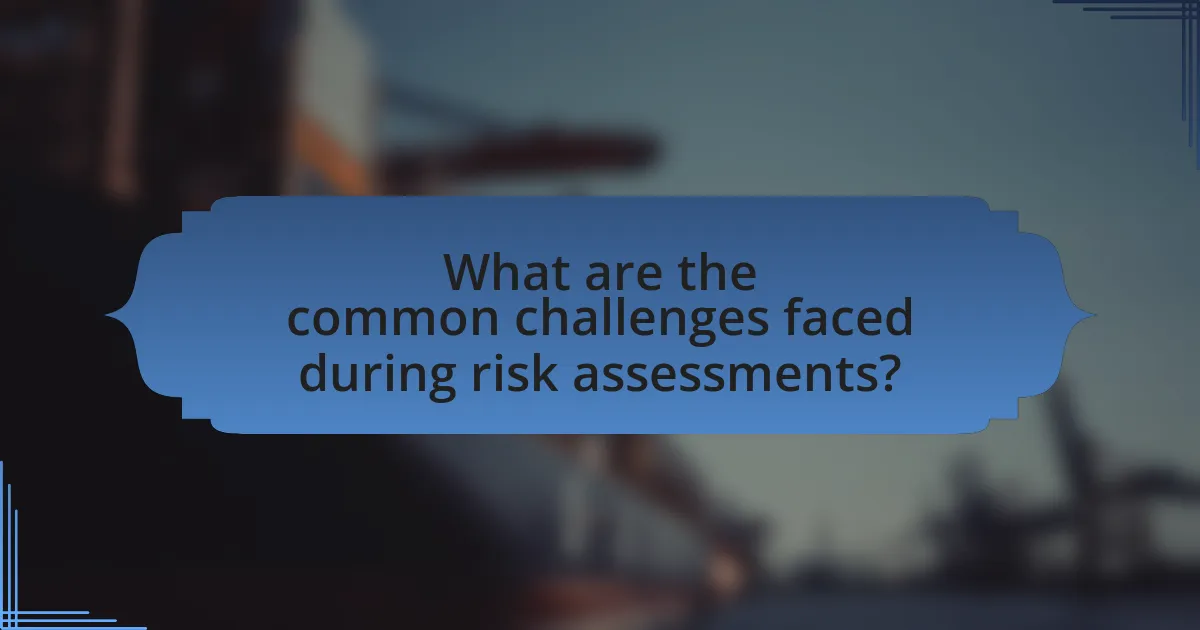
Common challenges faced during risk assessments include inadequate data collection, difficulty in identifying all potential hazards, and the subjective nature of risk evaluation. Inadequate data collection often leads to incomplete assessments, as accurate information is crucial for identifying risks effectively. Difficulty in identifying all potential hazards arises from the complexity of industrial environments, where numerous factors can contribute to risk. The subjective nature of risk evaluation can result in inconsistent assessments, as different individuals may perceive risks differently based on their experiences and biases. These challenges can hinder the effectiveness of risk assessments and ultimately impact safety outcomes in industrial settings.
What factors can hinder the risk assessment process?
Several factors can hinder the risk assessment process, including inadequate data, lack of expertise, and organizational culture. Inadequate data can lead to incomplete risk evaluations, as accurate assessments rely on comprehensive information about potential hazards and their impacts. Lack of expertise among team members can result in misinterpretation of risks or failure to identify critical hazards, which diminishes the effectiveness of the assessment. Additionally, an organizational culture that does not prioritize safety can create resistance to implementing necessary changes based on risk assessment findings, ultimately undermining the process.
How can organizational culture impact risk assessment outcomes?
Organizational culture significantly impacts risk assessment outcomes by influencing employee behavior, communication, and decision-making processes. A strong safety-oriented culture encourages proactive identification and reporting of risks, leading to more comprehensive assessments. For instance, organizations with a culture that prioritizes transparency and open communication tend to have higher incident reporting rates, which enhances the accuracy of risk evaluations. Research by the National Institute for Occupational Safety and Health (NIOSH) indicates that companies with positive safety cultures experience fewer workplace accidents, demonstrating a direct correlation between culture and risk management effectiveness.
What are the common misconceptions about risk assessments?
Common misconceptions about risk assessments include the belief that they are solely about identifying hazards, that they are a one-time activity, and that they guarantee safety. Risk assessments are comprehensive processes that not only identify hazards but also evaluate risks and implement controls. They should be conducted regularly and updated as conditions change, rather than being a one-off task. Additionally, while risk assessments help in understanding and mitigating risks, they do not eliminate all risks, as some level of risk is inherent in any industrial activity.
How can these challenges be overcome?
To overcome challenges in conducting risk assessments in industrial settings, organizations should implement a systematic approach that includes thorough training, regular audits, and the use of advanced risk assessment tools. Training ensures that personnel are knowledgeable about potential hazards and assessment methodologies, which enhances the accuracy of the evaluations. Regular audits help identify gaps in the risk assessment process and ensure compliance with safety regulations. Advanced tools, such as software for hazard identification and risk analysis, streamline the assessment process and improve data accuracy. For instance, a study by the National Institute for Occupational Safety and Health found that organizations using structured risk assessment tools reported a 30% reduction in workplace incidents.
What best practices can be implemented to enhance the risk assessment process?
To enhance the risk assessment process, organizations should implement a systematic approach that includes regular training, comprehensive data collection, and stakeholder involvement. Regular training ensures that all personnel are aware of the latest risk assessment methodologies and tools, which improves accuracy and effectiveness. Comprehensive data collection involves gathering historical incident data, safety audits, and employee feedback, which provides a solid foundation for identifying potential risks. Stakeholder involvement, including input from employees at all levels, fosters a culture of safety and ensures that diverse perspectives are considered, leading to more thorough risk evaluations. These practices are supported by studies indicating that organizations with robust training and data-driven approaches experience fewer incidents and improved safety outcomes.
How can ongoing training improve risk assessment effectiveness?
Ongoing training enhances risk assessment effectiveness by ensuring that personnel remain updated on the latest safety protocols, risk factors, and assessment techniques. Regular training sessions reinforce knowledge and skills, enabling employees to identify potential hazards more accurately and respond appropriately. Research indicates that organizations with continuous training programs experience a 50% reduction in workplace incidents, as employees are better equipped to recognize and mitigate risks. This ongoing education fosters a culture of safety, leading to improved compliance with regulations and a proactive approach to risk management.
What are the legal and regulatory requirements for risk assessments in industrial settings?
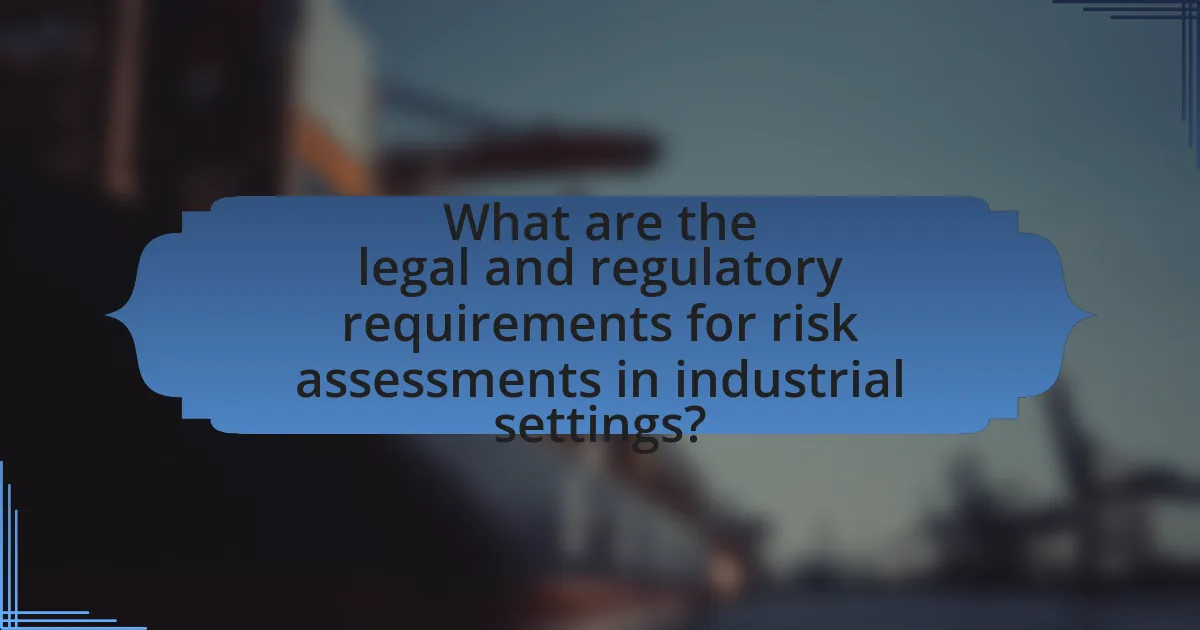
Legal and regulatory requirements for risk assessments in industrial settings mandate that employers identify, evaluate, and mitigate risks to ensure worker safety and compliance with laws. In many jurisdictions, regulations such as the Occupational Safety and Health Administration (OSHA) standards in the United States require employers to conduct risk assessments as part of their safety programs. These assessments must be documented and updated regularly, particularly when there are changes in operations or new hazards are identified. Additionally, the European Union’s Framework Directive 89/391/EEC emphasizes the need for risk assessments to protect workers from occupational hazards, requiring employers to implement preventive measures based on the findings. Compliance with these regulations is essential to avoid legal penalties and ensure a safe working environment.
What laws govern risk assessments in various industries?
Laws governing risk assessments in various industries include the Occupational Safety and Health Administration (OSHA) regulations in the United States, which mandate employers to assess workplace hazards and implement safety measures. Additionally, the Health and Safety at Work Act 1974 in the UK requires employers to ensure the health and safety of employees by conducting risk assessments. In the European Union, the Framework Directive 89/391/EEC establishes a general framework for occupational safety and health, emphasizing the need for risk assessments. These laws are designed to protect workers and ensure safe working environments by requiring systematic identification and evaluation of risks.
How do compliance requirements vary by region or country?
Compliance requirements vary significantly by region or country due to differing legal frameworks, cultural norms, and industry standards. For instance, the European Union enforces strict regulations such as the General Data Protection Regulation (GDPR), which mandates data protection and privacy, while the United States has a more fragmented approach with sector-specific regulations like HIPAA for healthcare and CCPA for consumer privacy. Additionally, countries like Japan have unique compliance requirements that emphasize quality management systems, as seen in their adherence to ISO standards. These variations reflect the local legal, economic, and social contexts, necessitating tailored compliance strategies for organizations operating internationally.
What are the penalties for failing to conduct proper risk assessments?
Failing to conduct proper risk assessments can result in significant penalties, including fines, legal liability, and increased insurance costs. Regulatory bodies, such as the Occupational Safety and Health Administration (OSHA) in the United States, impose fines that can range from thousands to millions of dollars depending on the severity of the violation. Additionally, companies may face lawsuits from employees or stakeholders if negligence is proven, leading to further financial repercussions. These penalties underscore the importance of adhering to risk assessment protocols to ensure workplace safety and compliance with legal standards.
How can organizations stay updated on regulatory changes?
Organizations can stay updated on regulatory changes by subscribing to industry newsletters, attending relevant conferences, and utilizing regulatory tracking software. These methods provide timely information on new regulations and amendments. For instance, the Regulatory Affairs Professionals Society offers resources and updates that help organizations remain compliant with evolving regulations. Additionally, many industries have specific associations that publish updates and provide training on regulatory changes, ensuring that organizations are informed and can adapt their practices accordingly.
What resources are available for monitoring compliance requirements?
Resources available for monitoring compliance requirements include regulatory compliance software, industry-specific guidelines, and professional compliance organizations. Regulatory compliance software, such as GRC (Governance, Risk, and Compliance) platforms, helps organizations track and manage compliance obligations efficiently. Industry-specific guidelines, like those from the Occupational Safety and Health Administration (OSHA) or the Environmental Protection Agency (EPA), provide essential standards for compliance in industrial settings. Additionally, professional compliance organizations, such as the Compliance Institute or the International Compliance Association, offer resources, training, and certifications to ensure adherence to compliance requirements. These resources collectively support organizations in maintaining compliance and mitigating risks effectively.
How can industry associations assist in understanding regulations?
Industry associations assist in understanding regulations by providing resources, guidance, and advocacy tailored to specific sectors. They often publish detailed reports, guidelines, and best practices that clarify regulatory requirements, making it easier for businesses to comply. For instance, the American National Standards Institute (ANSI) offers standards that help organizations interpret and implement regulations effectively. Additionally, industry associations frequently host workshops and training sessions, enabling members to engage with experts who explain complex regulatory frameworks. This support is crucial, as it helps businesses navigate the often intricate landscape of compliance, ultimately reducing the risk of violations and enhancing operational safety.
What are the best practices for conducting a risk assessment in industrial settings?
The best practices for conducting a risk assessment in industrial settings include identifying hazards, assessing risks, implementing control measures, and reviewing the assessment regularly. Identifying hazards involves recognizing potential sources of harm, such as machinery, chemicals, or ergonomic issues. Assessing risks requires evaluating the likelihood and severity of incidents associated with these hazards, often using a risk matrix for clarity. Implementing control measures entails applying the hierarchy of controls, prioritizing elimination, substitution, engineering controls, administrative actions, and personal protective equipment. Regularly reviewing the assessment ensures that it remains relevant and effective, particularly when changes occur in processes, equipment, or personnel. These practices are supported by guidelines from organizations such as the Occupational Safety and Health Administration (OSHA) and the National Institute for Occupational Safety and Health (NIOSH), which emphasize systematic approaches to risk management in industrial environments.
How can regular reviews and updates improve risk assessment accuracy?
Regular reviews and updates enhance risk assessment accuracy by ensuring that the evaluation reflects current conditions and emerging threats. This process allows organizations to identify changes in operational environments, regulatory requirements, and technological advancements that may impact risk levels. For instance, a study by the National Institute of Standards and Technology indicates that continuous monitoring and periodic reassessment can lead to a 30% improvement in risk identification and mitigation strategies. By integrating new data and insights, organizations can make informed decisions, thereby reducing the likelihood of unforeseen incidents and enhancing overall safety.
What role does employee involvement play in effective risk assessments?
Employee involvement is crucial for effective risk assessments as it enhances the identification and evaluation of potential hazards. Engaging employees who are familiar with daily operations provides valuable insights into risks that may not be apparent to management. Studies show that organizations with active employee participation in risk assessments report a 30% reduction in workplace incidents, highlighting the effectiveness of this collaborative approach. Furthermore, involving employees fosters a culture of safety, encouraging proactive reporting of hazards and contributing to more comprehensive risk management strategies.
